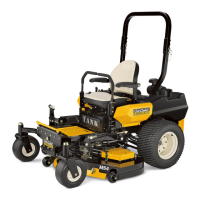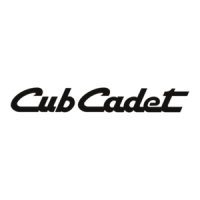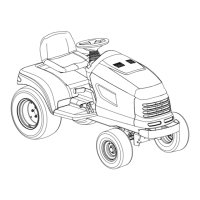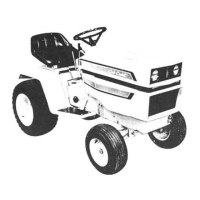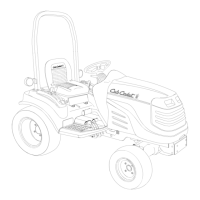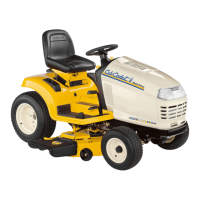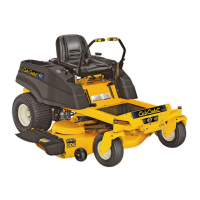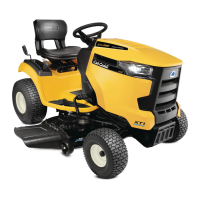23se c t i O n 5 — Op e r a t i O n
Using the Mower Deck
WARNING! Make certain the area to be mowed is
free of debris, sticks, stones, wire or other objects
that can be thrown by the rotating blades.
NOTE: Do not engage the mower deck when lowered in grass.
clutch will result. Fully raise the deck or move to a non grassy
area before engaging the mower deck.
Mow across slopes, not up and down. If mowing a slope,
start at bottom and work upward to ensure turns are made
uphill.
2. he first pass pick a point on the opposite side of the
area to be mowed.
En
throttle control to the fast position.
Low4. er the mower deck to the desired height setting using
the deck lift pedal.
5.
forward to move the tractor forward, and keep the tractor
headed directly toward the alignment point.
NOTE: The speed of the tractor will affect the quality of
the mower cut. Mowing at full speed will adversely affect
the cut quality. Control the ground speed with the control
levers.
W6. hen approaching the other end of the strip, slow down
or stop before turning. A U-turn is recommended unless a
pivot or zero turn is required.
Align the mower with an edge of the mowed strip and 7.
Direct the tractor on each subsequent strip to align with a 8.
previously cut strip.
To prevent rutting or grooving of the turf, if possible,
change the direction that the strips are mowed by
mowing.
WARNING!
to the highest position before crossing.
NOTE: When stopping the tractor for any reason while on a grass
surface, always:
Engage the parking brake,
Doing so will minimize the possibility of having your lawn
engine.
Checking the Safety Interlock Circuits
working properly. If a safety circuit is not working as designed,
properly. To check the safety circuits, proceed as follows:
opened fully outward, disengage the parking brake and
momentarily turn the ignition switch to the start position.
The engine should not crank.
2.
to the engaged position. Momentarily turn the ignition
switch to the start position; the engine should not crank.
one of the drive control levers from the fully outward
neutral position. The engine should stop running. Repeat
the procedure with the opposite control lever.
Move both control levers fully outward in the neutral 4.
position and disengage the parking brake; then lift upward
With both control levers fully outward in the neutral 5.
stop.
Mower Cutting Blades
The blades normally “factory installed” on a mower afford
the best grass cutting performance on the majority of grasses
and mowing conditions; however, there will be occasions
whereby the grass type, stage of grass growth, soil conditions,
and weather conditions will require different cutting blade
orientation of one cutting blade to an adjacent blade (I.E., the
blades do not need to be “timed” nor synchronized).
Hi-lift — These are generally the best cutting blades for most
grasses and mowing conditions. These blades will provide extra
“lift” for the thinner leaf grasses, will handle lush grasses, and
will provide maximum grass and debris discharge. These blades
are generally required for material collection systems. More
horsepower is required for these blades when compared to
others, and they generally produce the highest noise levels.
Medium-lift — These blades require less horsepower than the
hi-lift, and they generally work well in wider leaf grasses and
some mulch applications.
Low-lift — These blades require less horsepower than hi-lift
and medium-lift blades, and they generally work best with wide
leaf grasses, sparse grass growth, and sandy soil conditions.
are configured without offset, and with a maximum amount of
sharpened cutting edge.
Mulch- These blades are generally designed for use in cutting
decks equipped with mulch baffles. The shape of the blade
generally produces higher turbulence in order that the grass can
be repeatedly cut and re-cut into smaller pieces. These blades
generally require more horsepower than other blades. Mulch
blades work best when the grasses are cut at the highest levels,
minimal lengths of grasses are removed, and grass conditions are
generally dry.
NOTE: Refer to the attachment and accessories section for a list
of part numbers.
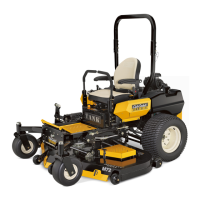
